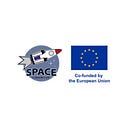Introducing the SPACE Consortium
The SPACE Consortium aims to build an innovative learning method for primary school pupils between 10–12 that teaches them about STEM, space and Earth. For this, we employ the latest technologies such as Virtual Reality and 4D effects.
The learning method that the SPACE Consortium will develop will be made available to all European schools and should also be locally adaptable to cater to the different curricula and educational traditions in the countries and regions of the European Union. Hence it is vital for the consortium to work transnationally with schools and educational experts from 4 EU countries. By exploring new and innovative ways to educate children on the EU climate goals (European Green Deal) and the environment and offering them tools from STEM to make a contribution, children can have a tremendous impact on the future of our world.
Our goals
- Raise awareness amongst pupils between the age of 10–12 about the environment and the EU climate goals.
The SPACE Consortium’s approach is positive; we intend to teach students how science and technology can help us to both identify and solve environmental and climate-related problems. - Increase the willingness of pupils between 10–12 to act on the environment and the EU climate goals.
We want pupils to feel they too can make a difference to help our planet in positive and tangible ways: from citizen science and environmental clean ups, to saving energy schemes in their schools or homes. Experiencing the Overview Effect for themselves in tandem with an integrated education method will help participants to become actively engaged and responsible citizens, creative and innovative and able to work collaboratively and fully aware of the challenges facing society. - Improve the quality of STEM education.
We do this in three ways:
(1) Develop an interest in children for STEM related topics through innovative teaching methods. By showing how science and technology can help us to reach the climate goals of the European Green Deal, we aim to instil a long-lasting interest in STEM-related topics in children.
(2) Make STEM-education more engaging and fun. By creating innovative new technology-enabled forms of learning, we aim to make STEM more accessible and interesting for this digital savvy generation. We want to use experiential forms of learning to move beyond only knowledge transfer to application of knowledge (here, using STEM as a means to help achieve the EU climate goals). This can ultimately improve the quality of STEM-education in Europe. Many children are under-skilled in STEM, while STEM professionals play a necessary role in the sustained growth and stability of the European Economy.
(3) Help teachers develop skills for and improve their self-efficacy around STEM-related topics. The SPACE Consortium identified that it is important to help teachers feel confident that they can teach STEM-related topics. Therefore, the program contains a series of open-access tools for teachers to help them teach the different STEM-related lessons that the SPACE Consortium education program offers.
The ultimate goal is to develop an education program that will raise awareness on the environment and the EU climate goals amongst primary school children (age 10-12), increase their willingness to act and improve the quality of STEM-education in Europe.
Thanks for reading! Make sure to follow us on our YouTube channel and on LinkedIn.
The SPACE Consortium is a transnational collaboration of education professionals from France, Hungary, Italy and the Netherlands and is co-funded by the European Union.
